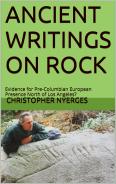An excerpt from "Ancient Writing on Rocks."
[This book, and others by Nyerges, are available from Kindle, Amazon, or the Store at www.SchoolofSelf-Reliance.com.]
HOW’D THEY GET HERE, REVISITED: BOATS
Remember, there was
a challenge when news of this discovery first appeared in the local newspaper. I was asked, “How
did (they) get all the way over here?” ["They" being whomever inscribed these rocks in a Western European language]
Of course, my answer was “boats.” (How else?!!)
Trans-Pacific and trans-Atlantic travel almost certainly
occurred, bringing various travelers to North and South America in the
pre-Columbian days.
Even one of the biggest skeptics of diffusionism, Eric
Lurio, author of “A Fractured History of the Discovery of America,” admits that
oceanic voyages to North America occurred.
Lurio did his research, and seems to know of every theory of contact
with the Old and New World, and generally only discusses the aspects of these theories
which help to debunk each one. For example, although the average 3rd
grader will look at the giant Olmec heads from Mexico and tell you they look
African, Lurio will tell you that certain features we regard as “African”
aren’t actually that rare south of the Rio Grande. Really? Should we wonder
why? Most of Lurio’s arguments are not
objectively scientific, but rather involved lots of fun and ridicule.
To be fair, Lurio’s premise is that just getting to America
doesn’t constitute a “discovery” – he lists his 3 “rules” which he regards as
the basis for a discovery by his definition, and based on those rules, Columbus
wins.
Nevertheless, he admits that folks sailed all the way across
the Atlantic to the L’Anse Aux Meadow in Newfoundland around 986 A.D., but he
dismisses any evidence that folks may have sailed further south. The Kensington Stone, the Newport Tower,
Saint Brendan, and Madoc are all regarded as hoaxes, frauds, or fairy tales.
But when it comes to
sweet potatoes, he recognizes that they are native to North America and somehow
became popular with Polynesians before 1492.
“Just how the Polynesians got them is a mystery,” writes Lurio. “Either an Amerindian must have gotten to
Polynesia, or a Polynesian must have gotten to America,” he admits.
On page 49 of his book, he describes artifacts that were
found in 1975 at the tip of the Olympic Peninsula in Washington which have
continued to perplex archaeologists. At
the site, called Ozette, there was apparently a massive landslide around 1495
to 1500 which buried everything, and even such perishable things as baskets
were preserved.
Archaeologists found a few dozen smelted iron knives blades
and pieces of bamboo in the excavation.
According to Lurio, the current theory is that “some poor Japanese
sailors got caught in a storm and were blown out to sea. They drifted along the Kirusiro, or Japanese
current, for six months or so before being shipwrecked on the American west
coast. It’s been estimated that there
were two or three such shipwrecks per century…
“Transpacific contact happened. But it was nothing like what its advocates say. The plain fact is that except for the Arctic
– where the Pacific is only 56 miles across and there was plenty of contact,
trans-Pacific contact was limited to tiny incidents that, with the exception of
the Polynesian discovery of the sweet potato and maybe some 5,000-year-old
pottery designs, left absolutely no impact on either the Asians or the
Amerindians. So this cannot qualify as
a ‘discovery’ of America.”
Indeed! I was never
arguing about “discovery” here, just that ancient people could and did travel
the oceans, and that ample evidence shows that they could, and did, get here to
the west coast of the U.S.
That’s what Thor Heyerdahl spent his life trying to prove,
and he did it with little reed boats.
Back in the days of Julius Caesar, battles were fought on
the Mediterranean using huge ships, not small reed boats like Heyerdahl. Two Roman era ships recovered in Lake Nemi
were about 230 and 240 feet long, with 37-foot-long oars, putting to rest the
debate whether or not the Romans actually could have built ships as big as they
described in their writings. Clearly, these were vessels capable of sailing the
open sea. [See also Julius Caesar’s descriptions
of Celtic boats in Book 3 of his De Bello Gallico (Gallic Wars), written in 56
B.C.E.]
[Continued in the book]

No comments:
Post a Comment